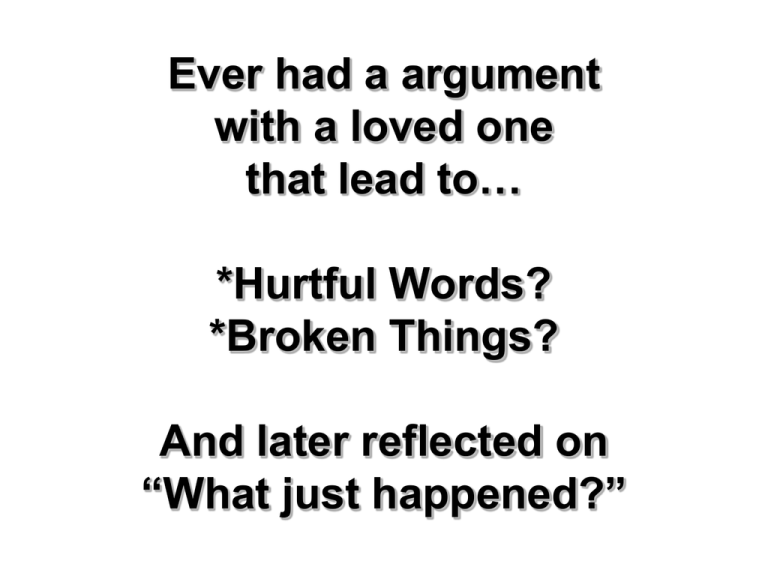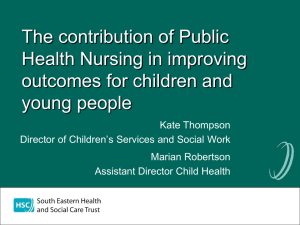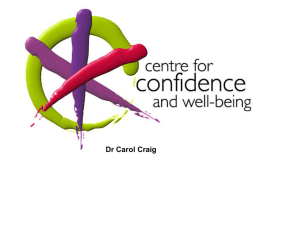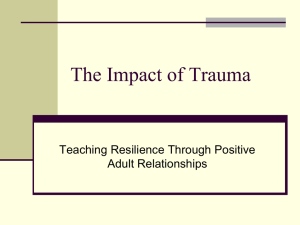
Ever had a argument
with a loved one
that lead to…
*Hurtful Words?
*Broken Things?
And later reflected on
“What just happened?”
The 2 Brains
Human Brain
&
Primitive Brain
The Cerebral Cortex:
Thinking/Personality Brain
The Cerebral Cortex:
Thinking/Personality Brain
Evaluates emotions in a
more sophisticated manner
Impulse control, planning,
organization, personality
Making meaning & choices
The Cerebral Cortex:
Thinking/Personality Brain
Large in Humans
Our Individuality
How We Take Action
“we rule the world
because of our large
brains”
The Brain Stem:
Primitive/Survival Brain
The Brain Stem:
Primitive/Survival Brain
Controls the rhythms of life:
heartbeat, waking, sleeping,
breathing, cyclical release of
hormones
Arousal systems
Reaction to threat:
fight, flight or freeze
The Brain Stem:
Primitive/Survival Brain
As Animals we…
Eat, Breathe, Move
Make waste prodcts
Make babies
The Limbic System
The Emotional Brain
Human Brain – in our control
We think and control urges
Primitive Brain – out of our control
Fast response and urges
The Stress Response System
Video 1 Video 2
The alarm reaction
A quick, complex, total body
response to a serious threat
The body is mobilized for
“fight, flight or freeze”
Physiological Changes Involved in the
Alarm Response (Fight or Flight)
Increased heart rate, blood pressure & breathing
Release of glucose + increased muscle tone
Nervous system changes increased focus on
the threat and tuning out of everything else
Stress hormones (adrenaline, cortisol) are the
messengers that initiate all of the above
The Story of a Soldier
The Basic Instinct to Survive
Fight Flight Freeze
When the threat is so overwhelming
there is no hope in fighting or fleeing
Freeze – Submission - Collapse
The body prepares to be injured
Heart rate slows, blood moves from
extremities to inner organs
The mind detaches from current situation
Natural endorphins are released which
decreases perception of anxiety and pain
The Story of a Student
Overwhelmed, can’t think and
becomes detached from reality
Physiological Problems Constant High
Levels of Stress Hormones
High Blood Pressure
High Glucose Levels (weight gain, diabetes)
Cortisol inhibits anti-inflammatory chemicals to
inflammation lead to pain (fibromyalgia)
With high levels of stress hormones (adrenaline,
cortisol) the body downgrades the receptors.
Memories are hard to make (hard to learn)
Early Brain
Development
• Nurturing, responsive, and
individualized interactions
from birth build healthy
brain structure.
• Healthy brain architecture is
the necessary foundation
required for optimal future
learning, behavior and
health.
Regional Child Abuse Prevention Councils 2011
The brain develops in the
context of human relationships
Review of Brain Development
Most of Brain Development
Occurs in the Early Years
Stress and the Brain
• Excessive and repeated stress:
– Neglect, violence
– Chaos, unpredictability
– Hostility, rejection
• Causes disruption of brain architecture:
– Impairs cell growth
– Interferes with healthy neural circuits
Regional Child Abuse Prevention Councils 2011
Regional Child Abuse Prevention Councils 2011
Flashbacks
Trauma memories that have not
been verbally integrated and
come back in the form of
sensory memories that make it
feel as if the trauma were
occurring again in the here and
now.
Trauma Triggers
Flashbacks are most often triggered by
a non-verbal memory
Sights
Sounds
Smells
Bodily sensations
Emotional reactions
Motor memories
Death
The ACE pyramid
Whole Life Perspective
Early Death
Conception
Disease, Disability
and Social Problems
Scientific Gaps
Adoption of Health
risk Behaviours
Social, Emotional and
Cognitive Impairment
Adverse Childhood Experiences
25
Some findings so far...
Increased risk of:
lung cancer
auto immune disease
prescription drug use
chronic obstructive airways disease
poor health related quality of life.
26
Neurobiology
Neglect and
the brain
Parietal lobe
Frontal lobe
Reading comprehension area
Structures tend to be
fixed by birth, but the
connections and
functions carry on
being sorted until
early adulthood.
Occipital lobe
Motor speech
area of Broca
Pons
Sensory speech area of Wernicke
Cerebellum
27
Healthy brain
Front
Temporal lobes
Back
An abused brain
Front
Temporal lobes
Back
Most activity
Least activity
28
Illustration based on actual PET scan images - Center for Disease Control and Prevention
Positive Stress
Tolerable Stress
Toxic Stress
Normal and essential part
of healthy development
Brief increases in heart rate
and blood pressure
Mild elevations in hormonal
levels
Example: Tough test at
school. Playoff game.
Body’s alert systems
activated to a greater
degree
Activation is time-limited
and buffered by caring
adult relationships.
Brain and organs recover
Example: Death of a loved
one, divorce, natural
disaster
Occurs with strong, frequent
or prolonged adversity
Disrupts brain architecture
and other organ systems
Increased risk of stressrelated disease and
cognitive impairment
Example: abuse, neglect,
caregiver substance
dependence or mental
illness
Intense, prolonged, repeated, unaddressed
Social-Emotional buffering, Parental Resilience,
Early Detection, Effective Intervention
What are ACEs?
Adverse Childhood Experiences
• ACEs are experiences in childhood that are
unhappy, unpleasant, hurtful
• Sometimes referred to as toxic stress or
childhood trauma
What are the
Adverse Childhood Experiences?
1. Child physical abuse
2. Child sexual abuse
3. Child emotional abuse
4. Physical Neglect
5. Emotional Neglect
6. Mentally ill, depressed or suicidal
person in the home
What are the
Adverse Childhood Experiences?
7. Drug addicted or alcoholic family member
8. Witnessing domestic violence against the mother
9. Loss of a parent to death
or abandonment,
including abandonment
by divorce
10. Incarceration of any
family member
ACEs often last a lifetime . . .
but they don’t have to
• Healing can occur
• Cycle can be broken
• Safe, stable, nurturing
relationships heal
parent and child
Family Centered Practice, June 8, 2007
Adverse Childhood Experiences
vs. Adult Alcoholism
18
16
% Alcoholic
14
12
10
8
6
4
2
0
0
1
2
ACE Score
3
>=4
% With a Lifetime History of
Depression
Childhood experiences underlie
chronic depression
80
70
60
50
40
30
20
10
0
Women
Men
0
1
2
ACE Score
3
>=4
ACE score vs. serious job problems
% with Job Problems
18
16
14
12
10
8
6
4
2
0
0
1
2
ACE Score
3
4 or more
ADVERSE CHILDHOOD EXPERIENCES
The Most Powerful Determinate of the Public’s Health
Abuse and Neglect
1. Child physical abuse
2. Child sexual abuse
3. Child emotional abuse
4. Neglect
Indicators of Family Dysfunction
5. Mentally ill, depressed or suicidal person in the home
6. Drug addicted or alcoholic family member
7. Witnessing domestic violence against the mother
8. Parental discord – indicated by divorce, separation, abandonment
9. Incarceration of any family member
ACE Score: the number of categories of adverse childhood experience to which a
person was exposed.
ACEs INFLUENCE VIA BIOLOGIC IMPACT ON
NEURODEVELOPMENT
BRAIN
Hormones, chemicals &
cellular systems prepare
for a tough life in an evil
world
INDIVIDUAL
•Edgy
•Hot temper
•Impulsive
•Hyper vigilant
•“Brawn over
brains”
BRAIN
Hormones, chemicals &
cellular systems prepare
for life in a benevolent
world
INDIVIDUAL
•Laid back
•Relationshiporiented
•Thinks things
through
•“Process over
power”
OUTCOME
Individual &
species survive
the worst
conditions.
TRAUMATIC
STRESS
NEUTRAL
START
OUTCOME
Individual &
species live
peacefully in
good times;
vulnerable in
poor conditions
ACEs HAVE MANY IMPACTS THROUGHOUT THE LIFESPAN
PSYCHIATRIC
DISORDERS
CHRONIC
DISEASE
CRITICAL
& SENSITIVE
DEVELOPMENTAL
PERIODS
IMPAIRED
COGNITION
Early childhood, ages 7-9,
Pre-puberty,
Aging into adulthood
ADVERSE
CHILDHOOD
EXPERIENCE
MORE CATEGORIES – GREATER
IMPACT
Physical Abuse, Sexual Abuse
Emotional Abuse, Neglect
Witnessing Domestic Violence
Depression/Mental Illness in Home
Incarcerated Family Member
Substance Abuse in Home
Loss of a Parent
WORK/SCHOOL
Attendance, Behavior,
Performance
BRAIN
DEVELOPMENT
Electrical, Chemical,
Cellular Mass
Hard-Wired Into
Biology
ALCOHOL,
TOBACCO,
DRUGS
RISKY SEX
GENETICS
Including gender –
Remember that
experience triggers
gene expression
(Epigenetics)
OBESITY
ADAPTATION
CRIME
INTERGENERATIONAL
TRANSMISSION,
DISPARITY
POVERTY
CHRONIC DISEASE
Current Smoking
Diabetes
28.5
30
25
Percent of Population
Percent of Population
BEHAVIORAL HEALTH
20.8
20
16.3
13.2
15
10.4
11.1
10
5
0
0
1
2
3
4 or 5
Number of ACE Categories
14
12
10
8
6
4
2
0
11.7
7.5
0
6,7, or 8
6
5.1
6
3.7
4
2
2
0
0
1
2
3
4 or 5
Number of ACE Categories
6,7, or 8
Percent of Population
Percent of Population
10.2
7.3
7.9
1
2
3
4 or 5
Number of ACE Categories
6,7, or 8
Cardio Vascular
Disease
10
8
7.5
6.1
Risk for HIV
12
8
9.4
10
8.1
8
6
6.7
4.9
5.6
5.6
4
2
0
0
1
2
3
4 or 5 6,7, or 8
Number of ACE Categories
DISABILITY
MENTAL HEALTH
30
25
20
15
10
5
0
Health Problems
Require Special
Equipment
24.5
19.3
11
14
15.5
7.3
0
1
2
3
4 or 5
Number of ACE Categories
6,7, or 8
Percent of Population
Percent of Population
Treatment for Mental
Health Condition
20
15
10
5
0
14.8
5.2
0
5.2
6.4
8.6
11.3
1
2
3
4 or 5
Number of ACE Categories
6,7, or 8
ACEs INFLUENCE VIA BIOLOGIC IMPACT ON
NEURODEVELOPMENT
BRAIN
Hormones, chemicals &
cellular systems prepare
for a tough life in an evil
world
TRAUMATIC
STRESS
INDIVIDUAL
•Edgy
•Hot temper
•Impulsive
•Hyper vigilant
•“Brawn over
brains”
OUTCOME
Individual &
species survive
the worst
conditions.
Normal Biologic Response to Toxic Stress
Can Make Parenting Harder
NEUTRAL
START
BRAIN
Hormones, chemicals &
cellular systems prepare
for life in a benevolent
world
INDIVIDUAL
•Laid back
•Relationshiporiented
•Thinks things
through
•“Process over
power”
OUTCOME
Individual &
species live
peacefully in
good times;
vulnerable in
poor conditions
Impact of ACEs on Brain
Development
A PET scan of a normal brain (left) shows a high level of brain activity in the temporal lobes of the brain.
The temporal lobes are responsible for regulating emotions and receive input from the senses. The
temporal lobes on the right are from a severely traumatize child in which the lobes are inactive. Children
with damage to this part of the brain suffer sever emotional and cognitive problems as well as have difficulty
in making and/or sustaining positive relationships.
Top 10 risk factors for
death in the USA
smoking,
severe obesity,
physical inactivity,
depression,
suicide attempt,
alcoholism,
illicit drug use,
injected drug use,
50+ sexual partners,
history of STD
Regional Child Abuse Prevention Councils 2011
ACE Score
and Teen Sexual Behaviors –
National Data
Percent With Health Problem (%)
45
40
ACE Score
0
1
2
3
4 or more
35
30
25
20
15
10
5
0
Intercourse by
Age 15
Teen Pregnancy
Teen Paternity
Relationship Between Number of Adverse Childhood
Experiences and Adolescent Pregnancy
60
50
40
30
20
10
0
0
1
2
3
4
ACE Score
5
6
7-8
ACE Score and HIV Risks
20
Percent With Health Problem (%)
18
16
14
ACE Score
0
1
2
3
4 or more
12
10
8
6
4
2
0
Ever Injected
Drugs
Had 50 or More
Intercourse Partners
Ever Had an
STD
Percent attempted (%)
The ACE Score and the Prevalence of
Attempted Suicide
20
15
10
5
0
0
1
2
ACE Score
3
>=4
High Residential Mobility (>8 moves) During
Childhood by ACE Score
Percent who moved
8 or more times (%)
30
25
20
15
10
5
0
0
1
2
3
ACE Score
4 or 5
>=6
“…early experiences help
to determine brain structure,
thus shaping the way people
learn, think, and behave for
the rest of their lives.”
I Am Your Child
Reiner Foundation
Taking care of yourself
Self-care checklist
•
•
•
•
•
•
•
•
•
Physical fitness
Nutrition and hydration
Sleep and rest
Assertiveness skills
Centering and solitude
Creative activities
Fun and enjoyment
Support provided & recieved
Set and monitored goals
“The solution of all
adult problems
tomorrow depends
in large measure
upon the way our
children grow up
today.”
- Margaret Mead,
Anthropologist
Regional Child Abuse Prevention Councils 2011
What Are ACEs?
Adverse Childhood Experiences
• ACEs are experiences in
childhood that are unhappy,
unpleasant, hurtful.
• Sometimes
referred to as
toxic stress or
childhood
trauma.
Regional Child Abuse Prevention Councils 2011
ACEs Often Last a Lifetime . . .
But They Don’t Have To
• Healing can occur
• The cycle can be
broken
• Safe, stable,
nurturing
relationships heal
parent and child.
Regional Child Abuse Prevention Councils 2011
Complete ACE Questionnaire
• What does it make you think about?
• Keep in mind your thoughts as we present
the ACE Study
Regional Child Abuse Prevention Councils 2011
What are Adverse Childhood
Experiences (ACEs)?
• Growing up (prior to age 18) in a
household with:
•
•
•
•
Recurrent physical abuse.
Recurrent emotional abuse.
Sexual abuse.
Emotional or physical neglect.
Regional Child Abuse Prevention Councils 2011
Growing up (prior to age 18) in a
household with (cont):
• An alcohol or drug abuser
• An incarcerated household member.
• Someone who is chronically depressed,
suicidal, institutionalized or mentally ill.
• Mother being treated violently.
• One or no parents.
Regional Child Abuse Prevention Councils 2011
Why is This Important?
Because ACEs are:
• Surprisingly common
• Occur in clusters
• The basis for many common public health
problems
• Strong predictors of later social functioning,
well-being, health risks, disease, and death
Regional Child Abuse Prevention Councils 2011
ACE Scores
•1/3 of adults have an
ACE score of 0
•The majority of adults
with an ACE score of 0
have few, if any, risk
factors for diseases that
are common causes of
death in the US.
Regional Child Abuse Prevention Councils 2011
ACE’s are Highly Interrelated
Alcohol Abuse in the Home and the Risk of Other
Household Exposures During Childhood
Regional Child Abuse Prevention Councils 2011
•An ACE Score of 4 or more results in having multiple
risk factors for these diseases or the disease
themselves.
•An ACE score of 6 or more results in a 20 year
decrease in life expectancy.
Regional Child Abuse Prevention Councils 2011
Evidence Suggests:
• Many chronic diseases in adults are
determined decades earlier, by
experiences in childhood
• Risk factors/behaviors for these diseases
are initiated during childhood or
adolescence and continue into adult life.
Regional Child Abuse Prevention Councils 2011
Seeking to Cope
• The risk factors/behaviors underlying
these adult diseases are actually effective
coping devices.
• What is viewed as a problem is actually a
solution to bad experiences.
• Dismissing these coping devices as “bad
habits” or “self destructive behavior”
misses their functionality.
Regional Child Abuse Prevention Councils 2011
Family Centered Practice, June 8, 2007
Regional Child Abuse Prevention Councils 2011
Behavior is Predictable
All behavior has meaning - both good behavior
and bad behavior
We need to look closely
at what preceded the
behavior - What happened
first that is causing this
behavior?
Regional Child Abuse Prevention Councils 2011
Life in a Tough World
If trauma/toxic stress
occurs early in life,
the brain becomes
wired to survive it.
Regional Child Abuse Prevention Councils 2011
By adolescence, children
seek relief through:
•
•
•
•
•
•
Drinking alcohol
Smoking tobacco
Sexual promiscuity
Using drugs
Overeating/eating disorders
Delinquent behavior
Regional Child Abuse Prevention Councils 2011
High Risk Teen Behaviors
• May not be the core problem
• They may be the coping devices
• A way to feel safe or just feel better
Regional Child Abuse Prevention Councils 2011
Adverse Childhood Experiences
vs. Smoking as an Adult
20
18
16
14
12
10
8
6
4
2
0
0
1
2
3
4-5
6 or more
ACE Score
Regional Child Abuse Prevention Councils 2011
Adverse Childhood Experiences
vs. Adult Alcoholism
18
16
% Alcoholic
14
12
10
8
6
4
2
0
0
1
2
3
>=4
ACE Score
Regional Child Abuse Prevention Councils 2011
ACE Score vs.
Intravenous Drug Use
% Have Injected Drugs
3.5
3
2.5
2
1.5
1
0.5
0
0
1
2
3
4 or more
ACE Score
Regional Child Abuse Prevention Councils 2011
Adverse Childhood Experiences
vs. Likelihood of > 50 Sexual
Partners
Adjusted Odds Ratio
4
3
2
1
0
0
1
2
3
4 or more
ACE Score
Regional Child Abuse Prevention Councils 2011
% have Unintended PG, or AB
ACE Score vs. Unintended
Pregnancy or Elective Abortion
80
Unintended Pregnancy
70
Elective Abortion
60
50
40
30
20
10
0
0
1
2
3
4 or more
ACE Score
Regional Child Abuse Prevention Councils 2011
% With a Lifetime History of
Depression
Childhood Experiences
Underlie Chronic Depression
80
70
60
50
40
30
20
Women
Men
10
0
0
1
2
3
>=4
ACE Score
Regional Child Abuse Prevention Councils 2011
Childhood Experiences
Underlie Later Suicide
25
% Attempting Suicide
20
15
10
5
0
0
1
2
3
>=4
ACE Score
Regional Child Abuse Prevention Councils 2011
% with Job Problems
ACE Score vs.
Serious Job Problems
18
16
14
12
10
8
6
4
2
0
0
1
2
3
4 or more
ACE Score
Regional Child Abuse Prevention Councils 2011





